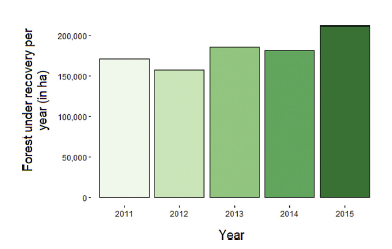
Analysis of the Pact for the Atlantic Forest Restoration identified the recovery of approximately 740 thousand hectares of forests. The goal is to recover 1 million hectares by 2020.
For the first time a study was able to estimate the current stage of restoration of native forests in the Brazilian Atlantic Forest. According to the article “There is hope for achieving ambitious Atlantic forest restoration commitments“, published on Sunday (2) in the scientific journal Perspectives in Ecology and Conservation, about 740 thousand hectares of forests were recovering between 2011 and 2015 in the biome.
The study was produced by the Pact for the Atlantic Forest Restoration, a movement created in 2009 by companies, government agencies, civil society organizations and research centers to stimulate the restoration of 15 million hectares of degraded areas in the biome by 2050. The work involved more than 20 authors from 10 different institutions.
In 2011, the Pacto committed to the Bonn Challenge with the goal of restoring 1 million hectares of forests in the Atlantic Forest by 2020. The results of the study show that it is possible to meet this goal. “The numbers bring hope that ambitious restoration goals can be met, bringing benefits to the population and helping Brazil meet its international commitments,” said Renato Crouzeilles, study leader and researcher at the Centre for Conservation and Sustainability Science (CSRio). Brazil has committed to recovering 12 million hectares of native vegetation by 2030 in its National Plan for the Recovery of Native Vegetation and the Bonn Challenge.
The forest and landscape restoration is a crucial activity to recover degraded areas of the country, protecting biodiversity, springs, rivers, soil and widespread promotion of ecosystem services. In addition, restoration can move a native forest economy based on non-timber products, planting native trees for wood, collecting fruits, nuts, seeds and extracting active ingredients for drugs and essences.
“The study demonstrates the importance of multisectoral initiatives to gain scale and open up socioeconomic opportunities in the forest restoration chain,” says Severino Ribeiro, who was the coordinator of the Pact for the Atlantic Forest Restoration during the development of the study.
Ludmila Pugliese, current coordinator of the Pacto, stresses: “Society’s engagement in expanding the scale of restoration is vital, since this activity must be seen as a means of transforming society. We are communicating the positive response of all society to one of the greatest challenges of the century.”
The numbers of forest recovery
Using satellite mapping of the MapBiomas project, the work estimates that 673,000 to 740,000 hectares of native forests were recovering between the years 2011 and 2015 in the Brazilian Atlantic Forest. If this trend continues until 2020, the Pacto will exceed its restoration commitment, reaching the recovery of about 1.4 million hectares of native forests in the Brazilian Atlantic Forest.
The study estimates that about 300,000 hectares of forests were recovered by active restoration interventions by one of the 350 members of the Pacto. The rest may have been restored by other actors or be the result of natural regeneration, however, it is not possible to distinguish the contribution of each restoration technique.
According to the authors, the Brazilian Atlantic Forest registered positive results in the forest recovery due to three main factors: the development of a strategy of governance, communication and articulation in 14 of the 17 states within the Brazilian Atlantic Forest; establishment of a restoration monitoring system; and the promotion of vision and strategy to influence public policies and restoration actions in different spheres.
Public policies
Despite the good news of the Atlantic Forest recovery reported by the Pacto, these advances are at risk due to changes in environmental policies including collective governance structures without broad debate, and proposed changes to weaken the New Forest Code. Brazil’s socio-environmental policy for decades is an international reference, giving an additional value to Brazilian agricultural production and drawing great discussions about climate change, payment for environmental services, combating deforestation and consequently forest restoration. Harmonizing productive areas, the protection and recovery of forests and natural vegetation has been a differential for Brazil that needs to be conserved and deepened.
About Pacto
The Pact for the Atlantic Forest Restoration is a movement of Brazilian society, multistakeholder, integrating institutions willing to support or participate in forest restoration efforts. The aim of the Pacto is to articulate public and private institutions, governments, companies and landowners to integrate their efforts and resources in generating results in restoration and conservation of biodiversity. The goal of the Pacto is to enable forest restoration of 15 million hectares by the year 2050 in the Brazilian Atlantic Forest.


